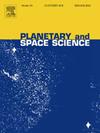以ResNet为骨干的掩膜R-CNN和U-Net架构月球陨石坑探测的对比分析
IF 1.7
4区 物理与天体物理
Q3 ASTRONOMY & ASTROPHYSICS
引用次数: 0
摘要
月球环形山的自动探测对于推进行星科学至关重要,可以实现高效的地质测绘、地表年龄估计和资源识别。本研究比较了Mask R-CNN(实例分割)和U-Net(语义分割)架构,使用ResNet作为月球陨石坑检测的主干。关键的新颖之处在于将模型在地理空间环境(ArcGIS Pro环境)和非地理空间环境中的性能进行比较,这是迄今为止从未尝试过的方法。使用Geocoded Chandrayaan-2 TMC-2 DEM数据进行训练和验证,采用了一种新的策略,有助于精确定位和精确检测小型、形态复杂的陨石坑。掩膜R-CNN的准确率为91%,召回率为85%,十字路口(IoU)为87%,在检测复杂的陨石坑边缘和识别陨石坑直径方面表现出色,具有准确的地理位置信息。然而,它很难探测到深度较低或边缘退化的陨石坑。相反,U-Net显示出更高的召回率(93%),但精度适中(85%),使其能够有效地完成更广泛的陨石坑定位任务。U-Net擅长识别形状完美的陨石坑,但在探测较大和非常小的陨石坑方面面临挑战。Mask R-CNN发现了以前未分类的陨石坑,特别是那些直径小于1公里的陨石坑,而U-Net擅长于发现更多重叠和嵌套的陨石坑,展示了它们的互补优势。这些发现强调了深度学习在加强月球研究和未来行星探索方面的潜力。本文章由计算机程序翻译,如有差异,请以英文原文为准。
Comparative analysis of mask R-CNN and U-Net architectures using ResNet as backbone for lunar crater detection
Automated detection of lunar craters is crucial for advancing planetary science, enabling efficient geological mapping, surface age estimation, and resource identification. This study compares Mask R-CNN (instance segmentation) and U-Net (semantic segmentation) architectures using ResNet as the backbone for lunar crater detection. Key novelty is comparing model performance in both a Geospatial context (ArcGIS Pro environment) and non-Geospatial environment a method not heretofore attempted. Training and validation were conducted using Geocoded Chandrayaan-2 TMC-2 DEM data, employing a new strategy that facilitates accurate localization and precise detection of small, morphologically complex craters. Mask R-CNN achieved a precision of 91 %, a recall of 85 %, and an Intersection over Union (IoU) of 87 %, excelling in detecting intricate crater edges and identifying crater diameters with accurate geolocation information. However, it struggled to detect craters with less depth or degraded rims. Conversely, U-Net demonstrated superior recall (93 %) but moderate precision (85 %), making it efficient for broader crater localization tasks. U-Net excelled at identifying perfectly shaped craters but faced challenges in detecting larger and very small craters. Mask R-CNN identified previously uncatalogued craters, particularly those smaller than 1 km in diameter, while U-Net excelled at detecting a greater number of overlapping and nested craters, showcasing their complementary strengths. These findings underscore the potential of deep learning to enhance lunar research and future planetary exploration.
求助全文
通过发布文献求助,成功后即可免费获取论文全文。
去求助
来源期刊

Planetary and Space Science
地学天文-天文与天体物理
CiteScore
5.40
自引率
4.20%
发文量
126
审稿时长
15 weeks
期刊介绍:
Planetary and Space Science publishes original articles as well as short communications (letters). Ground-based and space-borne instrumentation and laboratory simulation of solar system processes are included. The following fields of planetary and solar system research are covered:
• Celestial mechanics, including dynamical evolution of the solar system, gravitational captures and resonances, relativistic effects, tracking and dynamics
• Cosmochemistry and origin, including all aspects of the formation and initial physical and chemical evolution of the solar system
• Terrestrial planets and satellites, including the physics of the interiors, geology and morphology of the surfaces, tectonics, mineralogy and dating
• Outer planets and satellites, including formation and evolution, remote sensing at all wavelengths and in situ measurements
• Planetary atmospheres, including formation and evolution, circulation and meteorology, boundary layers, remote sensing and laboratory simulation
• Planetary magnetospheres and ionospheres, including origin of magnetic fields, magnetospheric plasma and radiation belts, and their interaction with the sun, the solar wind and satellites
• Small bodies, dust and rings, including asteroids, comets and zodiacal light and their interaction with the solar radiation and the solar wind
• Exobiology, including origin of life, detection of planetary ecosystems and pre-biological phenomena in the solar system and laboratory simulations
• Extrasolar systems, including the detection and/or the detectability of exoplanets and planetary systems, their formation and evolution, the physical and chemical properties of the exoplanets
• History of planetary and space research
 求助内容:
求助内容: 应助结果提醒方式:
应助结果提醒方式:


